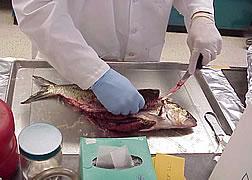EPA Region 1 Biology Laboratory
On this page
- About the EPA Region 1 Biology Laboratory
- Microbiology
- Aquatic Toxicity Testing
- Sediment Toxicity Testing
- Microtox Toxicity Testing
- Main Biology Laboratory
- Fish Tissue Processing
About the EPA Region 1 Biology Laboratory

The Biology Laboratory is a state-of-the-art laboratory which provides a variety of biological analyses and services including:
- Microbiology: conducting bacterial analyses to measure drinking water and surface water quality; inspection and certification of state and tribal drinking water laboratories. Learn more about the Region 1 Microbiology Team.
- Aquatic toxicity testing: testing the toxicity of surface waters and treatment plant discharges
- Sediment toxicity testing: testing sediments from lake and river bottoms for toxicity
- Polymerase chain reaction: a DNA splitting process used for identifying and differentiating between likely sources of human verses non-human (ducks, beavers, etc.) bacterial pollution in surface waters
- General biology: a main biology lab for fish processing, invertebrate identification and other assorted activities
Aquatic Toxicity Testing
Acute (short-term) and chronic (long-term) warm and cold water toxicity testing performed using single or multiple species that inhabit the water column such as:
- Water fleas (Daphnids)
- Fathead minnows
- Brook Trout
- Rainbow Trout
- Testing is performed on effluent, ambient surface water, pore water and elutriate.
Sediment Toxicity Testing
Acute(short-term) and chronic(long-term) toxicity testing involving aquatic macro-invertebrates that inhabit the upper areas of sediments found in ponds, lakes, rivers and streams. These organisms include:
- Non-biting midgefly larvae (Chironomus sp.)
- Amphipods (Hyalella)
Microtox Toxicity Testing
Toxicity testing involving the exposure of luminescing bacteria to aqueous and solid media. The amount of luminescence is related to the stress of the exposure.
Main Biology Laboratory
- Biological Sciences reference materials
- General microscopy
- Teaching/education
Fish Tissue Processing
Fish tissue processing /sample preparation includes:
- Physical measurement of individual fish for length and sexing
- Whole fish filleted, skinned, and scaled
- Scales, otoliths or spines removed for aging
- Filet and offal tissue prepared for contaminant analysis
